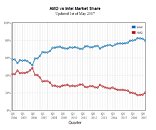Raevenlord
News Editor
- Joined
- Aug 12, 2016
- Messages
- 3,755 (1.19/day)
- Location
- Portugal
| System Name | The Ryzening |
|---|---|
| Processor | AMD Ryzen 9 5900X |
| Motherboard | MSI X570 MAG TOMAHAWK |
| Cooling | Lian Li Galahad 360mm AIO |
| Memory | 32 GB G.Skill Trident Z F4-3733 (4x 8 GB) |
| Video Card(s) | Gigabyte RTX 3070 Ti |
| Storage | Boot: Transcend MTE220S 2TB, Kintson A2000 1TB, Seagate Firewolf Pro 14 TB |
| Display(s) | Acer Nitro VG270UP (1440p 144 Hz IPS) |
| Case | Lian Li O11DX Dynamic White |
| Audio Device(s) | iFi Audio Zen DAC |
| Power Supply | Seasonic Focus+ 750 W |
| Mouse | Cooler Master Masterkeys Lite L |
| Keyboard | Cooler Master Masterkeys Lite L |
| Software | Windows 10 x64 |
There have been some reports that Intel's CPU division has gotten a sales decline of about $150 million, and that AMD has, conversely, seen its processor sales increase by around the same amount. This would seem to beget a straight, logic leap - that AMD was calling to itself sales that would have belonged to Intel. With Ryzen, AMD did make a great product that consumers are looking to buy, and if recent Passmark statistics are anything to go by, it would seem that yes, AMD achieved its sales increase on the back of Intel sales.

The data, pulled from PassMark's quarterly report, shows AMD gaining 2.2% of the processor market share against Intel - and one needs only look at the market share curve, its ups and downs, to notice just how much this occurrence looks against the trend. And one glance towards the blue Intel line is enough to notice that the company's market share has seemingly dropped by an approximate amount. Breaking a trend is usually the hardest part, and it would seem that AMD has done so, even through platform and motherboard availability issues, increasing consumer awareness for its brand and products and capitalizing on strong execution - an execution that too a long while to bring to fruition. This might be a tide-turner from AMD, and with its recent financial results announcement, it would seem AMD is working itself up, slowly, but surely. Here's hoping this marks a return to form from the red camp. You should, however, take these numbers with a grain of salt, since their origin (Passmark and its benchmarking suites) are hardly representative of the entire consumer spectrum.They do, however, give us a glimpse - if a frayed one at that.
EDIT: On account of the mention of AMD's 2017 fiscal year Q1 results, which have brought its stock tumbling, it's important to note the period Q1 F2017 pertains to only includes Ryzen's launch month of March, which was marred by low inventories and some availability problems with AM4 motherboards. As such, Ryzen sales only account for a month of these fiscal results. So, besides a knee-jerk reaction on a report that people expected to see much better than it is on account of Ryzen, let's just wait a bit until the dust settles and the selling-frenzy ends. I'm by no means a financial expert (not even close), but I would take up the falling AMD stocks right now, and look towards increasing share value on Q2 and Q3 fiscal 2017 reports.
View at TechPowerUp Main Site

The data, pulled from PassMark's quarterly report, shows AMD gaining 2.2% of the processor market share against Intel - and one needs only look at the market share curve, its ups and downs, to notice just how much this occurrence looks against the trend. And one glance towards the blue Intel line is enough to notice that the company's market share has seemingly dropped by an approximate amount. Breaking a trend is usually the hardest part, and it would seem that AMD has done so, even through platform and motherboard availability issues, increasing consumer awareness for its brand and products and capitalizing on strong execution - an execution that too a long while to bring to fruition. This might be a tide-turner from AMD, and with its recent financial results announcement, it would seem AMD is working itself up, slowly, but surely. Here's hoping this marks a return to form from the red camp. You should, however, take these numbers with a grain of salt, since their origin (Passmark and its benchmarking suites) are hardly representative of the entire consumer spectrum.They do, however, give us a glimpse - if a frayed one at that.
EDIT: On account of the mention of AMD's 2017 fiscal year Q1 results, which have brought its stock tumbling, it's important to note the period Q1 F2017 pertains to only includes Ryzen's launch month of March, which was marred by low inventories and some availability problems with AM4 motherboards. As such, Ryzen sales only account for a month of these fiscal results. So, besides a knee-jerk reaction on a report that people expected to see much better than it is on account of Ryzen, let's just wait a bit until the dust settles and the selling-frenzy ends. I'm by no means a financial expert (not even close), but I would take up the falling AMD stocks right now, and look towards increasing share value on Q2 and Q3 fiscal 2017 reports.
View at TechPowerUp Main Site
Last edited:






